Guest post by Wesley Johnston
On Memorial Day Weekend, GEDmatch announced a hugely important “Fallen Warriors-The Unknowns” initiative (click here for the details ).

Image by Jed Henry, from the documentary “Honoring a Commitment – The PFC Lawrence S. Gordon Story”, video on youtube and embedded below.
Family members of soldiers still missing in action from World War II and Korea can upload their autosomal DNA (aDNA) results to GEDmatch no matter what company did their test. And they can obtain the very important Individual Deceased Personnel File for their soldier. Plus everyone can upload their aDNA to increase the probability of matching with the DNA of an Unknown soldier.
GEDmatch’s initiative will bring the DNA of family members of those still missing into a database with which the DNA of any Unknown remains can be compared, easily, quickly and at minimal cost. In fact, GEDmatch probably already holds the DNA of family members of the Unknowns.
This is a wonderful thing for GEDmatch to do!!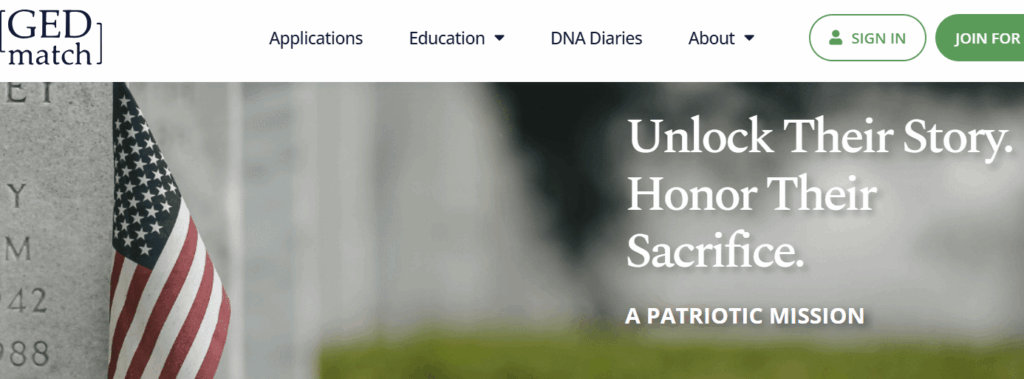
Genetic genealogy readers may know me from my work in genetic genealogy: my analytical tool articles in the Journal of Genetic Genealogy (JoGG), the many Family Tree DNA (FTDNA) projects I administer, the conferences I attend. One of the many other hats I wear is Historian of the US 7th Armored Division Association; another is Founding President of the American WWII Association Historians Consortium.
This is what led to me present “When John Doe is a WWII Unknown Soldier“ at the 2024 East Coast Genetic Genealogy Conference (ECGGC).
In our modern era, when law enforcement and the DNA Doe Project have embraced Investigative Genetic Genealogy (IGG) to solve cases in far shorter time and a far smaller cost, it is difficult to understand that the Defense POW-MIA Accounting Agency (DPAA), whose mission is “fullest possible accounting” relegates DNA to the last step of their years-long identification process of anthropologists examining remains, instead of the first step.
DPAA’s failure to lead with DNA is even more difficult to understand when they have the Armed Forces DNA Identification Laboratory (AFDIL) to do the DNA work. AFDIL is a world-class leader in DNA work, innovating (out of necessity) state-of-the-art methods in many ways. AFDIL staff also collaborated with FTDNA staff on the 2024 breakthrough research on George Washington’s Y-DNA. The list of authors reads like a Who’s Who of AFDIL and FTDNA (click here for that article and click the image for the article from cell.com).
So, at a time (1) when IGG success is making news every week identifying John and Jane Does or the perpetrators of long-unsolved violent crimes and (2) when AFDIL provides world-class state-of-the-art DNA expertise and (3) when the time and costs of using DNA up-front are far below the costs DPAA expends on years-long examination of remains by anthropologists that result in so few identifications every year, the question genetic genealogists have every reason to ask is: “Why is DPAA not embracing DNA – robust, state-of-the-art DNA, including IGG and use of DNA in public databases such as GEDmatch – as their first step?” (And also: why is no one in Congress raising these questions when budget and efficiency are so prominent? Why are we spending so much money to accomplish so little when the technology is there to do it better, faster and at far less cost?)
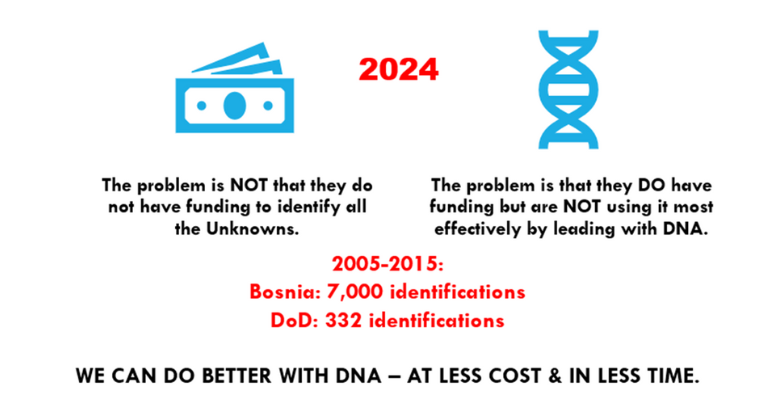
Image by Wesley Johnston, with Bosnia statistics from https://www.icmp.int/news/how-dna-profiling-helped-unravel-the-horror-of-bosnias-genocide/ and DPAA statistics from https://dpaa-mil.sites.crmforce.mil/dpaaRecentlyAccountedFor
I do not have the answers. But I do have years of experience working cases of Unknowns connected to 7th Armored Division. And I know that if the men buried as Unknowns had a voice, they would never stop asking to be reunited with their family.
I have watched too many family members go to their graves wondering what happened to their soldier. For them, WWII never really ended. The impact persists through the generations.
I have seen too many records of fathers who died within a year of learning of their son’s death, one by suicide who made it clear in his note that it was living with the reality of his son’s death that he could no longer tolerate.
I have spoken with too many veterans who have now also gone to their graves wanting to help me tell the stories of their buddies who were killed, especially the ones who have still — more than 80 years later — not been found and identified and could very well be among the thousands still buried as Unknowns.
I have worked two successful cases of Unknowns being identified. In one of them, DPAA-predecessor anthropologists insisted that the man (Private First Class Lawrence S. Gordon) we thought was the Unknown could not possibly be him. But fortunately, US Graves Registration in the late 1940s thought he was a German and turned his remains over to the Germans. And the modern Germans were very willing to allow DNA testing of the remains – which proved we were right and the anthropologists’ hubris was without merit. If he had been buried as an American, the anthropologists would never have agreed to his disinterment and DNA testing.
To see what this means for the families and others for whom “no man left behind” is more than just lip service, watch the video “Honoring a Commitment – The PFC Lawrence S. Gordon Story” on YouTube. Just the first 5 minutes will make clear just how much it means, but the whole story is worth watching.
DPAA deals with both recoveries of remains, some in very challenging locations, and identification of recovered Unknowns. More than 8,000 remains are already recovered and buried in U. S. military cemeteries as Unknowns.
DPAA’s work with the Unknowns is compounded by mistakes, both accidental and intentional, that their U.S. Graves Registration Service (GRS) post-war predecessors made in the late 1940s and 1950s. (Click here for the NYT article “DNA Can Now Identify Unknown Soldiers. It Also Reveals Tangles of Old Mistakes.” behind a paywall)
In addition to considering US soldier remains to be German and turning them over to the Germans, GRS was sometimes wrong about the identification so that men are now buried in a grave with another man’s name on the gravestone ( click here for the article ). Families who thought their soldier had been brought home do not realize he is still unaccounted and not the man buried in the grave they thought was his.
Worse, as made public in documented evidence in a recent legal case against DPAA, some GRS members intentionally combined bone pieces from different men to form a single set of remains (click here for that article ). And the unused bones from many men were put together in a single casket (there were many caskets like this) and buried as a single Unknown X-number (click here for the case of Manila X-4097).
Even worse, in some cases, GRS knew that they needed to cover up what they had done, and the cover-up itself was documented. They had destroyed the chain of custody of these pieces of bone – either those combined with others or those tossed with hundreds of others into a casket. No historian can tell when or where or how the bone was recovered. No anthropologist can tell what other bones it was recovered with. The only way to identify these isolated bones is to use DNA with a wide public database such as GEDmatch. The bones in the combined caskets alone could account for hundreds or even thousands of missing men – if they were DNA tested.
Thus, in addition to dealing with properly handled remains of Unknowns, DPAA’s mission of “fullest possible accounting” means DPAA must end these coverups and be fully transparent about the post-war GRS mistakes, both accidental and intentional.
But DPAA relies on the same 1940s and 1950s use of anthropologists and relegates DNA testing to be done only after years of anthropologists examining remains has failed to identify the remains. The modern anthropologists do know more than their 1940s predecessors. But when identification is impossible without DNA, why is DPAA not using state-of-the-art DNA using public databases such as GEDmatch?
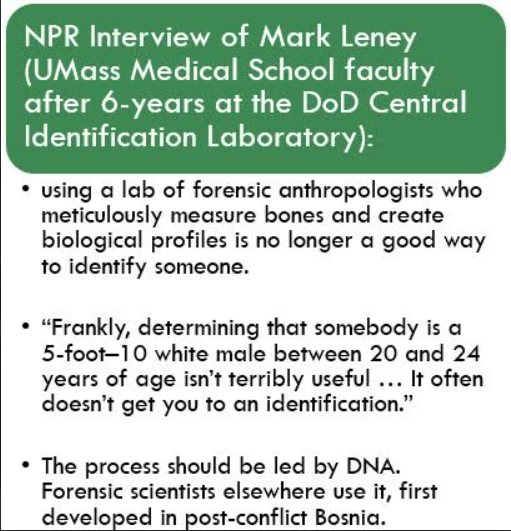
NPR Interview: Wesley Johnston, from the interview at https://apps.npr.org/grave-science/
So, this is the complex context in which GEDmatch now offers an opportunity to make things better. There is a lot that has gone wrong, for decades. Leading with DNA can correct the GRS mistakes made in past years if DPAA is transparent about those mistakes.
And if DPAA embraces up-front DNA use with IGG, the thousands of men buried as Unknowns will no longer be “Known but to God”. Their honored glory will restore their name and their family will finally see World War II come to an end.
GEDmatch’s marvelous initiative is a huge step toward truly doing fullest possible accounting and truly leaving no man behind.
This photo by Dutch citizen Niek Hendrix was at the U. S. Military Cemetery at Margraten, Netherlands, at the Memorial Day 2025 Ceremonies – the same weekend GEDmatch announced the “Fallen Warriors-The Unknowns” initiative. It is a flyover by four airplanes, executing the “Missing Man Formation” in which one plane leaves a hole in the formation to remember those who were lost. The cemetery over which the planes flew has hundreds of graves of Unknown US soldiers lost in World War II – men who GEDmatch’s initiative can hopefully help give them back their names and their families.
Editor’s note: A question I had was “What about the missing in more recent conflicts?” The answer is that perhaps the nature of war has changed, no more huge battles of infantry. Also the mission is to bring back everyone, even the bodies of the dead. There are only 6 MIA from the Iraq war. This web site shows the actual numbers for each conflict: https://dpaa-mil.sites.crmforce.mil/dpaaOurMissing
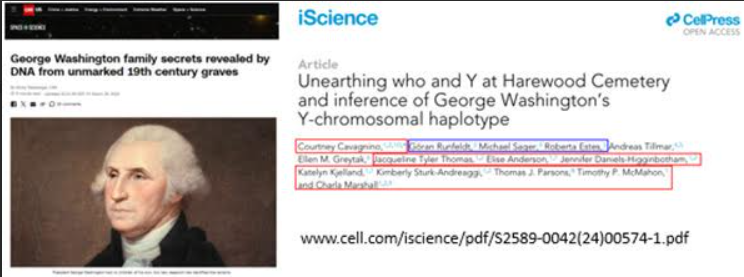
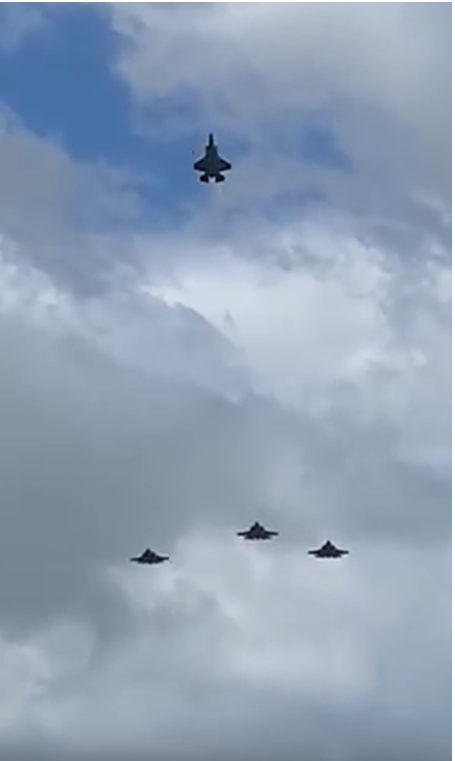
Hi Kitty. I can offer a personal story on this topic.
My mother’s cousin (US army airman) died in 1942 in a POW camp in The Philippines. His body was buried in a mass grave, no identification, with his remains mixed with others.
In 2017, a contract genetic genealogist working for the army contacted me. (I have a public tree at Ancestry which included the airman and that’s how the genealogist found me.)
I provided a DNA sample to him – I have the same mitochondrial DNA as the airman and share maybe 400 cM of autosomal DNA with him. I also provided contact information on genetically closer relatives who were on slightly different tree branches, to help affirm DNA identification.
It took quite a while (until 2023) but the army finally finished its ID process. The airman’s return and burial in the US happened two months ago. His long-deceased parents even had a gravesite and gravestone prepared for him, near them, in the hopes that he would, one day, come home.
Googling “Alvin Scarborough New York Post” provides a 2024 news story on the airman.
Thanks for this story. AFDIL now has far more capability than they did in 2017 when mtDNA was pretty much all they had. They can now use all forms of DNA.
Pingback: This week's crème de la crème - May 31, 2025 - Genealogy à la carteGenealogy à la carte
Pingback: Friday’s Family History Finds | Empty Branches on the Family Tree